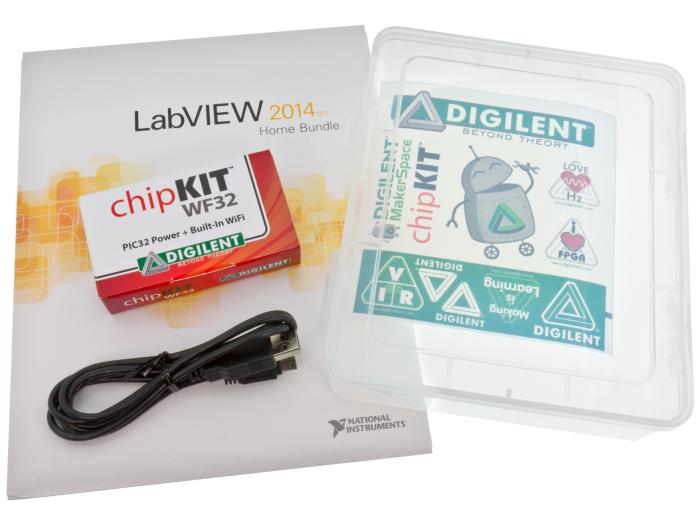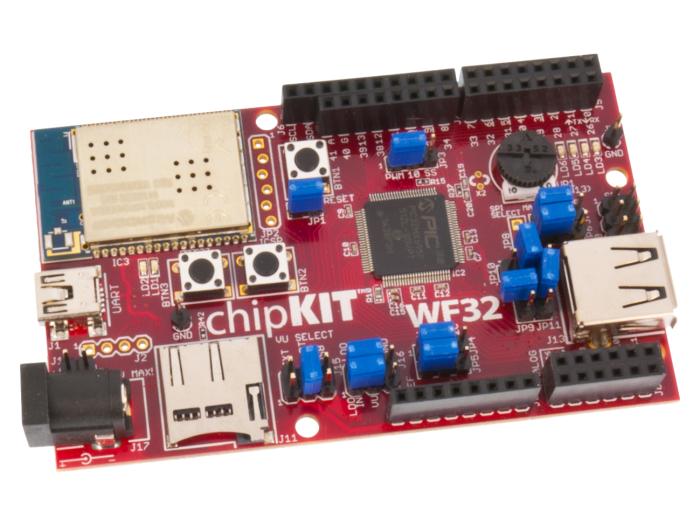Product description
LabVIEW is a graphical programming platform used for data acquisition & analysis, instrument control, prototyping and more. LabVIEW Home Bundle has made this powerful software affordable for makers and students. But what if you want to connect your LabVIEW projects to the physical world? That's why we've created the Physical Computing Kit.
The Physical Computing Kit comes with:
LabVIEW Home Bundle
chipKIT WF32 microcontroller board
Handy project box w/ sticker sheet
USB cable
We selected the WF32 because of its extensive onboard capabilities. It has a WiFi module that lets you communicate with a world of wireless devices, a Micro SD card slot for reading & storing large amounts of data, and a USB 2.0 controller for power, configuration, and your own USB applications. But that's just the beginning, because you'll also have access to the WF32's 43 available I/O pins. Connect whatever sensors, displays, controls, peripherals, etc. you like and LabVIEW Home will be able to use them.
Suppose you wanted to measure ambient light with a photocell, then turn another light on when the sensor reading drops below a certain threshold. (Commonly known as a 'dusk-to-dawn' circuit.) With LabVIEW Home, there's no need to wire up sensors, potentiometers, resistors, etc. on a breadboard. LabVIEW Home becomes the breadboard, allowing you to create a block diagram graphically.
In other words, you don't need to learn physical circuits in order to create useful experiments & projects.
You'll also be able to quickly create your own graphical user interfaces. Does your project need switches, buttons, dials, numeric displays, or more? You'll be able to choose from hundreds of controls, graphs, and 3D visualization tools, then simply drag-and-drop them into place.
The Physical Computing Kit comes with:
LabVIEW Home Bundle
chipKIT WF32 microcontroller board
Handy project box w/ sticker sheet
USB cable
We selected the WF32 because of its extensive onboard capabilities. It has a WiFi module that lets you communicate with a world of wireless devices, a Micro SD card slot for reading & storing large amounts of data, and a USB 2.0 controller for power, configuration, and your own USB applications. But that's just the beginning, because you'll also have access to the WF32's 43 available I/O pins. Connect whatever sensors, displays, controls, peripherals, etc. you like and LabVIEW Home will be able to use them.
Suppose you wanted to measure ambient light with a photocell, then turn another light on when the sensor reading drops below a certain threshold. (Commonly known as a 'dusk-to-dawn' circuit.) With LabVIEW Home, there's no need to wire up sensors, potentiometers, resistors, etc. on a breadboard. LabVIEW Home becomes the breadboard, allowing you to create a block diagram graphically.
In other words, you don't need to learn physical circuits in order to create useful experiments & projects.
You'll also be able to quickly create your own graphical user interfaces. Does your project need switches, buttons, dials, numeric displays, or more? You'll be able to choose from hundreds of controls, graphs, and 3D visualization tools, then simply drag-and-drop them into place.


